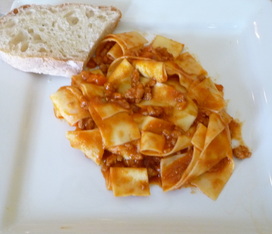| In one of my first attempts at blogging, I mentioned my recipe for Bolognese Sauce. Actually, it is not my recipe at all. As I noted then, the recipe comes from chef Mario Batali. The recipe has served me well for many years and has become one of my favorites for serving to special guests. As I mention in that earlier posting for this recipe, Bolognese Sauce was never served in my childhood home. Our heritage is southern Italian, in the Le Marche region, far away from Bologna in the Emilia-Romagna region of Italy. It was not part of my parents’ or grandparents’ culinary experience, so they never even considered preparing it. I’m not certain when I experienced Bolognese Sauce for the first time. It may have been in Bologna many years ago. Regardless of whenever or wherever that first experience occurred, Bolognese Sauce (or what I will prefer to call Ragu Bolognese) has been one of my all-time favorite Italian meals – especially when it is served with homemade pasta! When I retired in 2000 and had the time to pursue my long-standing interests in cooking in earnest, I discovered the Food Network and more importantly, Mario Batali’s first cooking show, Molto Mario. When he prepared Ragu Bolognese on one of his shows, I copied his recipe from the Internet and I had a new entry for my rapidly expanding recipe collection. His recipe is easy, reliable, and inexpensive. The flavors are wonderful, and the texture gives the sauce a mouth-feel unlike any other. Pair it with some homemade tagliatelle or pappardelle (as I noted above) and you have a touch of Italy that is unequaled – or so I thought! My wife and I are blessed with two wonderful (now adult) children who each have their own views of the ideal culinary experience. Both thoroughly enjoy Italian fare. Unlike my son, however, my daughter would rather eat it than cook it! Being the mother of three with a full-time professional career and an equally full slate of social commitments, that is completely understandable. I mention this because her professional career requires that she travel frequently domestically and internationally. Wherever she goes, and assuming her business schedule permits, her primary culinary objective is to find a local Italian restaurant. Even more special for me, I usually receive a photo or text each time she visits a new Italian restaurant in a new city. I now have firsthand proof there are excellent Italian dining establishments in Dallas, Philadelphia, Paris, Berlin, Budapest, and Prague. The list goes on. | "Authentic" Ragu Bolognese over tagliatelle served in Milan, Italy. Grandpa Joe's Ragu Bolognese over pappardelle. (I apologize for overlooking the parsley garnish!) |
I did most of my research online. Testing, of course, occurred in my kitchen. I found several recipes for Ragu Bolognese and discovered there were almost as many differences in the recipes as there were similarities. The recipes all used ground beef, ground pork, or ground veal. Sometimes only two (although infrequently the same two), and sometimes all three. Milk is a necessary ingredient but the amount varied as did the instruction on when to add it. Further “research” indicated that boiling the meat in the milk is important. The lactic acid softens the meat texture by breaking down the meat proteins.
As you can likely tell, I could continue with more detail than is necessary here. I will only add that after much reading and several test batches, I now claim my own recipe for Ragu Bolognese, which I am proud to share with you here. I hope you will find an opportunity to try it sometime soon.
Buon appetito.
P.S. Commercial packages of taggliatelle and pappardelle are not available everywhere, but I am finding them more and more often. They are typically bagged (rather than boxed) and the best of them have cooking times under five minutes.
P.P.S. My version of Ragu Bolognese is listed on the Recipes page as Ragu Bolognese. Chef Batali's version is listed as Bolognese Sauce.


 RSS Feed
RSS Feed